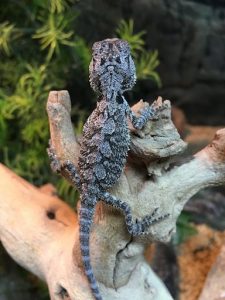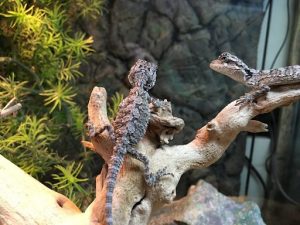Copyright 2021 Evolution Reptiles
All rights reserved.
Copyright 2025 Evolution Reptiles
All rights reserved.
All rights reserved.
The Minor, Western, or Dwarf, bearded dragon is a smaller species than the more familiar Pogona vitticeps, the common or Central bearded dragon. With a snout to vent length of 15cm and a tail that can be up to another 25cm, these small dragons inhabit a broad swathe of Western Australia, from the west coast to the great central plains. Even though all 7 bearded dragon species like very similar habitat niches, there is surprisingly little overlap of populations; between them, the whole country is covered with bearded dragons of one shape or another!

They grow rapidly after hatching, and reach their full size in just over a year; as with their larger cousins, they can live together as babies but appreciate their own space once they hit sexual maturity. General care is almost identical to that of their larger cousins; UVB is absolutely essential, with a T5 tube running 2/3 the length of the vivarium. Avoid compact UVB bulbs, as these do not provide the light intensity needed for a diurnal basking species. Despite their small size, they should always be kept in a vivarium of at least 120 x 60 x 60cm (4 x 2 x 2′) just like their larger cousins.
Temperature should be 35ºc in the warm end, dropping to 25º to 30ºc in the cool end. Directly under the basking spot it can rise as high as 42ºc, but do keep an eye on the overall gradient. Night temperatures can drop to around 20ºc, so in most modern centrally heated homes there will be no need to add night time heating to the vivarium. If night heating is required, it is best provided with a deep heat projector run through a suitable thermostat.

Regarded as semi-arboreal, they will appreciate rocks and branches in their vivarium. A basking platform set up under the main heat light will give them a sense of security, as they can see further around them when ‘on watch’. It also makes it slightly easier to give a good temperature gradient across the entire space. Make sure that there is sufficient cover for the young dragons to hide in if they get spooked; artificial plants are very useful for this, draped around and over the furniture of the vivarium. In general, avoid live plants – what they don’t eat they’ll dig up!
Substrates can be sand, wood chips, or one of the soil based mixtures. As long as temperatures are correct, a suitable supplementation regime is followed and a high level of UVB light is provided then there will be no problem with substrate eating which could lead to impaction.
They are omnivores, and can eat most leafy greens; leafy salads, such as rocket, watercress, dandelions and mixed salads are readily available and easy to use. Try to offer variety to keep a balanced diet. Salads should be offered every day, and lightly dusted with calcium or a good multivitamin/multimineral supplement. Avoid fruit, as the sugars are not good for their digestion – or their teeth! – although the odd blueberry now and again won’t do them any harm
Minor Dragons will eat locusts, crickets, mealworms, waxworms, roaches – in fact, any of the commercially produced insects are fine to use. Don’t forget to feed (gut load) your bugs, and dust them with calcium or a multivitamin/multimineral supplement before offering them to your dragon.
Fresh water should always be available. Even though these dragons come from a very dry part of the world, these are captive bred animals and should always have access to water. If they are reluctant to drink, they can be sprayed with tepid water, which they will lick off their noses. Always spray in the morning, and allow the vivarium to dry out completely before lights out.
This is an unusual species, a little more shy than the normal ‘beardie’ but worth a second look, especially if you’re looking for something different!
Common name: Minor dragon
Scientific Name: Pogona minor
Location: Western Australia
Habitat (wild): Arid woodland, rocky scrub
Captive environment: Tropical desert vivarium
Preferred temperature range: Daytime hot spot of 42ºc under the basking light, background ambient of 35ºc, cool end of 25º. Temperature can drop to 20ºc at night
Ferguson Zone: Zone 3
UVB: 10% or 12% T5 tube
Substrate: Dry sand, soil based mixture, wood chip
Lifespan: Unknown, but probably 8 – 10 years
Copyright 2021 Evolution Reptiles
All rights reserved.